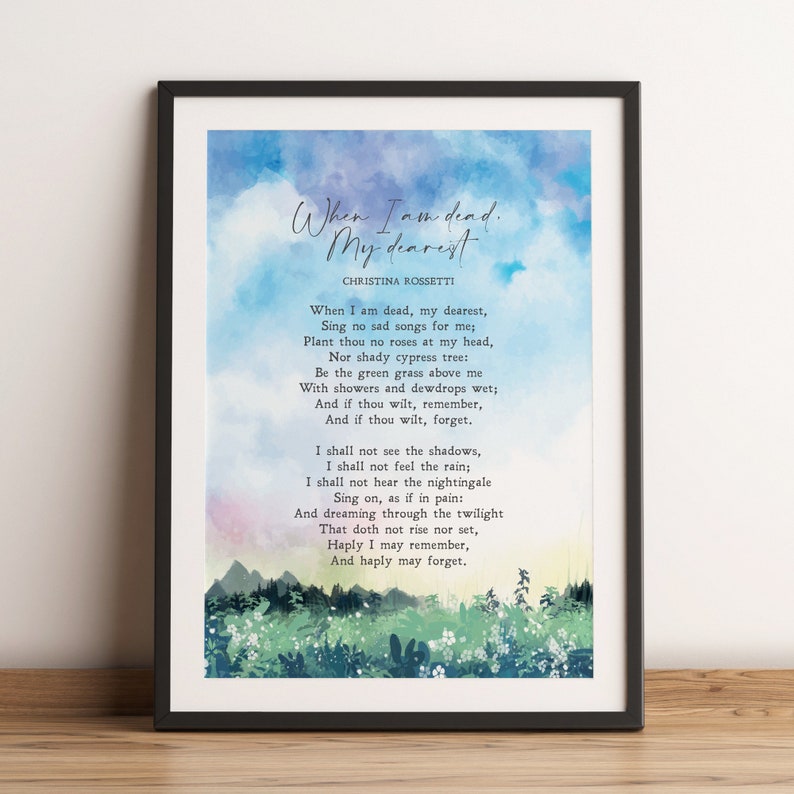

I shall not see the shadows, I shall not. In some traditions branches are carried at a funeral procession. When I am dead, my dearest, Sing no sad songs for me Plant thou no roses at my head, Nor shady cypress tree: Be the green grass above me With showers and dewdrops wet And if thou wilt, remember, And if thou wilt, forget. The ‘cypress tree’ is a powerful symbol of death. For example ‘Plant thou no roses… nor shady cypress tree’ expresses the protagonist’s hope that their lover does not mourn too long but but continues living positively. Rossetti uses the natural world as metaphors for remembrance.

The persona may be the poet, but more likely this is an imagery protagonist.Ī powerful feature is the rhythm, the use of syntactic parallels to establish the positive mood of acceptance. The voice is that of the first person singular ‘I’ addressing her lover. Home christina-georgina-rossetti Analyses. The mainly end-stopped lines suggest the emphatic nature of the speaker’s wishes. When I Am Dead, My Dearest by Christina Georgina Rossetti: poem analysis. 'When I am dead my dearest' by Christina Rossetti 'Sing no sad songs for me,' Christina Rossetti wrote in this. The rhyme scheme is a regular ABCB DEFE in both stanzas. Here are 16 non-religious funeral readings from poems, submitted for your approval. There is a jaunty rhythm which ensures the mood is more hopeful than sombre. The structure is regular, with the first, third, fifth and seventh lines having seven syllables and the alternating lines six. The poem comprises two stanzas of eight lines each. Instead she creates a mood of acceptance and peace. Even though Rossetti writes six of the sixteen lines in iambic trimeter, the abundance of variation throughout. She presents her stanzaic poem through two octaves with the pattern iambic abc4b3deFE3. These remain unresolved, yet despite this there is no tension in the poem. Christina Rossetti strategically structures her poem, 'When I am dead, my dearest' to convey her notion of love and death. She also conveys the importance of the connection between the living and the dead, how the wishes of the one who has passed away impacts on the lives of those left mourning them.Īn important feature is the trope of binary opposites, where the speaker and her lover are suspended between alternatives. She likes her tomb with green grass associated with showers and dewdrops. She does not want others to plant roses or shady cypress tree at her tomb. The poet addresses her dearest one and asks him not to sing sad songs for her when she is dead.

Rossetti weaves in a range of ideas memory, after-life, the human spirit, hope, patience and reassurance. The first stanza of the poem describes the world of the living people. It mirrors Rossetti’s Remember, which also deals with comforting a bereaved lover. The poetic device is a kind of epiphora.In this poem the speaker tries to comfort and reassure their lover after the s/he has died. The poet repeated the same word forget at the end of some neighboring stanzas. The poet used anaphora at the beginnings of some neighboring lines. When I am dead, my dearest is a remarkably accomplished song for Christina Rossetti to have written while still in her teens. When I Am Dead, My Dearest is a poem by Christina Rossetti, an English poet known best for her romantic poems and childrens poems. The author used lexical repetitions to emphasize a significant image and, i, not are repeated. Average number of symbols per line: 27 (strings are less long than medium ones) When I am dead, my dearest, Sing no sad songs for me Plant thou no roses at my head, Nor shady cypress tree: Be the green grass above me With showers and.Average number of symbols per stanza: 220.Use the criteria sheet to understand greatest poems or improve your poetry analysis essay. The information we provided is prepared by means of a special computer program.


 0 kommentar(er)
0 kommentar(er)
